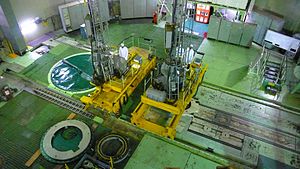Madras Atomic Power Station located at Kalpakkam about 80 kilometres (50 mi) south of Chennai, India, is a comprehensive nuclear power production, fuel reprocessing, and waste treatment facility that includes plutonium fuel fabrication for fast breeder reactors (FBRs). It is also India's first fully indigenously constructed nuclear power station. It has two units of 220 MWe capacity each. The first and second units of the station went critical in 1983 and 1985 respectively. The station has reactors housed in a reactor building with double shell containment ensuring total protection even in the remotest possibility of loss of coolant accident. An Interim Storage Facility [ISF] is also located in Kalpakkam.
History
Madras Atomic Power Station was built to strengthen the nuclear capability of India, and it laid the foundation for the indigenisation of India's nuclear power programme. The plant was constructed during the Prime Ministership of Indira Gandhi. The MAPS-1 reached criticality on July 2, 1983 and it was synchronised to the grid on July 23, 1983 in the presence of Prime Minister Indira Gandhi.
During its construction, a total of 3.8 lakh (380,000) railway sleeper (logs) were brought from all over India to lift the 180-tonne critical equipment in the first unit, due to lack of proper infrastructure and handling equipment.[1]
Reactors
The facility houses two indigenously built CANDU type PHWRs called MAPS-1 and MAPS-2. MAPS-1 was completed in 1981, but start-up was delayed due to a shortage of heavy water. After procuring the necessary heavy water, the MAPS-1 went critical in 1983 and began operating at full power on January 27, 1984. MAPS-2 obtained criticality in 1985 and began full power operations on March 21, 1986.[2] The two Pressurized Heavy Water Reactors (PHWR) are capable of generating 170MWe each which is lower than the designed power of 235MWe since some zircaloy pieces from the cracked cooling system were found in a moderator pump.[3]
A beachhead at Kalpakkam also hosts India's first indigenous Pressurized (light) water reactor (PWR). The 80 MW reactor was developed by BARC as the land based prototype of the nuclear power unit for India's nuclear submarines
[4] This unit does not come under MAPS.
Health issues
In 2012, the Department of Atomic Energy for the first time admitted that the deaths of some employees and their dependents at the Kalpakkam nuclear site were caused by multiple myeloma, a rare form of bone marrow cancer linked to nuclear radiation. The DAE acknowledged that nine people, including three employees working at the Madras Atomic Power Station at Kalpakkam died of multiple myeloma and bone cancer between 1995 and 2011. This information came to light in response to a Right to Information (RTI) inquiry from October 2011. The DAE had previously stonewalled all previous requests for information.[5]


